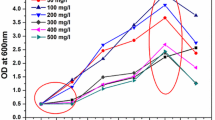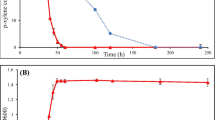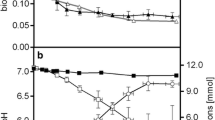Summary
The present study describes the growth of Pseudomonas putida cells (ATCC 33015) in batch and continuous cultures on two toxic substrates; toluene and m-toluic acid as sole carbon and energy sources. In fed-batch cultures on m-toluic acid up to 3.55 g cell dry weight/1 were achieved with a maximal specific growth rate (μmax) of 0.1 h-1. The average cellular yield was 1.42 g cell dry weight/g m-toluic acid utilized. When liquid toluene was added to shake-flask cultures in the presence of 0.7 g/1 m-toluic acid, the average cellular yield obtained was 1.3 g cell dry weight/g toluene utilized and the μmax was 0.13 h-1. Growth on toluene vapour in the presence of 0.7 g/l m-toluic acid in batch cultures resulted in a cellular yield of 1.28 g cell dry weight/g toluene utilized, with growth kinetics almost identical to those with liquid toluene (μmax liquid=0.13 h-1, μmax vapour=0.12 h-1). The maximal biomass concentration was 3.8 g cell dry weight/l, obtained in both cases after 100 h of incubation. Pseudomonas putida was grown in a chemostat initially on 0.7 g/l m-toluic acid and vapour toluene and then in the steady state on toluene as the sole source of carbon and energy. Toluene was added continuously to the culture as vapour with the inflowing airstream. Chemostat cultures could be maintained at steady state for several months on toluene. The maximal biomass concentration obtained in the chemostat culture was 3.2 g cell dry weight/l. The maximum specific growth rate was 0.13 h-1, with a cellular yield of 1.05 g cell dry weight/g toluene utilized. Approximately 70% of the toluene consumed was converted into biomass, and the remainder was converted to CO2 and unidentified byproducts.
Similar content being viewed by others
References
Abbott BJ, Gledhill WE (1971) The extracellular accumulation of metabolic products by hydrocarbon-degrading microorganisms. Adv Appl Microbiol 14:249–388
Atlas RM (1981) Microbial degradation of petroleum hydrocarbons: an environmental perspective. Microbiol Rev 45:180–209
Bauchop T, Elsden SR (1960) The growth of microorganisms in relation to their energy supply. J Gen Microbiol 23:457–469
Chakrabarty AM (1976) Plasmids in Pseudomonas. Annu Rev Genet 10:7–30
Clarke PH, Laverack PD (1984) Growth characteristics of Pseudomonas strains carrying catabolic plasmids and their cured derivatives. FEMS Microbiol Lett 24:109–112
Der Yang R, Humphrey AE (1975) Dynamic and steady state studies of phenol biodegradation in pure and mixed cultures. Biotechnol Bioeng 17:1211–1235
Friello DA, Mylroie JR, Gibson DT, Rogers JE, Chakrabarty AM (1977) XYL, A non-conjugative xylene degradative plasmid in Pseudomonas. J Bacteriol 127:1217–1224
Gibson DT, Koch JR, Kallio RE (1968) Oxidative degradation of aromatic hydrocarbons by microorganisms. 1) Enzymatic formation of catechol from benzene. Biochemistry 7:2653–2662
Goldberg I, Rock JS, Ben-Bassat A, Mateles RI (1976) Bacterial yields on methanol, methylamine, formaldehyde, and formate. Biotechnol Bioeng 28:1657–1668
Goldberg I (1985) Single Cell Protein. Springer Verlag, Heidelberg
Hardy K (1981) Bacterial Plasmids. Cole JA, Knowles CJ (eds) In: Aspects of Microbiology. Nelson Press
Higgins IJ, Best DJ, Hammond RC (1980) New findings in methane-utilizing bacteria highlight their importance in the biosphere and their commercial potential. Nature 280:561–564
Hill GA, Robinson CW (1975) Substrate inhibition kinetics of phenol degradation by Pseudomonas putida. Biotechnol Bioeng 17:1599–1615
Jones GL, Jansen F, McKay AJ (1973) Substrate inhibition of the growth of bactererium NCIB 8250 by phenol. J Gen Microbiol 74:139–148
Keshavarz T (1982) The stability of TOL plasmids in strains of Pseudomonas putida grown in chemostat cultures. PH. D. Thesis. University College London
Molin G (1981) The impact of dilution rate and attached growth on steady state characteristics of Pseudomonas putida. Eur J Appl Microbiol Biotechnol 13:102–106
Molin G, Nilsson I (1985a) Degradation of phenol by Pseudomonas putida ATCC 11172 in continuous culture at different ratios of biofilm surface to culture volume. Appl Environ Microbiol 50:946–950
Molin G, Nilsson I (1985b) Sand administration as an instrument for biofilm control of Pseudomonas putida ATCC 11172 in chemostat cultures. Biotechnol Bioeng 27:117–120
Pirt SJ (1975) Principles of Microbe and Cell Cultivation. Blackwell, Oxford
Wheelis ML (1975) The genetics of dissimilatory pathways in Pseudomonas. Ann Rev Microbiol 29:505–524
Williams PA, Worsey MJ (1976) Ubiquity of plasmids in coding for toluene and xylene. metabolism in soil bacteria: evidence for existence of TOL plasmids. J Bacteriol 125:818–828
Williams PA (1981) Catabolic Plasmids. Trends Biochem Sci 6:23–26
Author information
Authors and Affiliations
Rights and permissions
About this article
Cite this article
Vecht, S.E., Platt, M.W., Er-El, Z. et al. The growth of Pseudomonas putida on m-toluic acid and on toluene in batch and in chemostat cultures. Appl Microbiol Biotechnol 27, 587–592 (1988). https://doi.org/10.1007/BF00451637
Received:
Accepted:
Issue Date:
DOI: https://doi.org/10.1007/BF00451637




